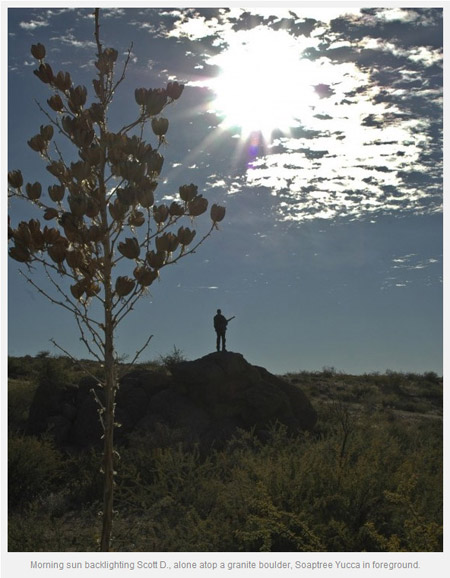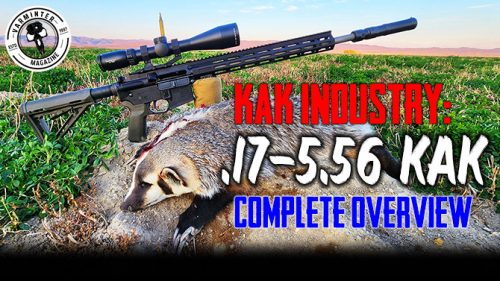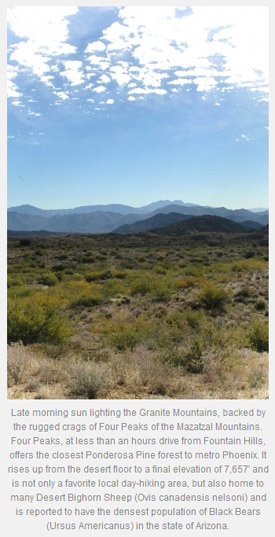 December is a magical time in Arizona’s desert country, especially for those individuals that enjoy the outdoors: Winter flowers are in bloom, the desert retains most of it’s green from the recent late fall rains and desert airgunners are rewarded with crisp morning temperatures in the high 40’s to low 50’s that are almost guaranteed to turn into perfect 70 degree afternoons.
December is a magical time in Arizona’s desert country, especially for those individuals that enjoy the outdoors: Winter flowers are in bloom, the desert retains most of it’s green from the recent late fall rains and desert airgunners are rewarded with crisp morning temperatures in the high 40’s to low 50’s that are almost guaranteed to turn into perfect 70 degree afternoons.
Combine the above with a fellow airgun enthusiast who’s company you thoroughly enjoy and the stage is set for a perfect Saturday morning! I made a deal with my hunting buddy and friend Scott D., aka “Chief” (being that I spent four years as an avionics technician assigned to the 965th AWACS, I have respect for his 33 year career and retirement from the USAF) that if he arrived at my house at 6:00 am, I would have a big pot of coffee waiting. We filled our to-go cups and headed out to “jackrabbit central” in the high desert foothills north of Cave Creek, Arizona (see information at end of this article for information useful to airgunners interested in hunting this area).
We topped our Benjamin Marauders (his a Greg Davis-tuned .22, mine a factory-stock .25) with air, slipped on our lightweight jackets and left his truck behind and headed into prime jack rabbit country. We start by employing a technique that I have to 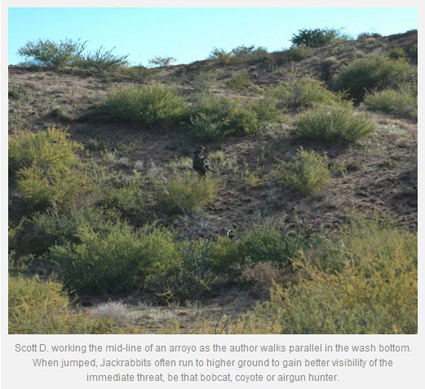 work well in the desert: We walked parallel to one another as we followed along an arroyo down to a lower elevation with one of us walking up high near the top of the ridge for better game-spotting visibility with the other walking the bottom of the sand-covered washes which are usually thickly covered at either side with vegetation.
work well in the desert: We walked parallel to one another as we followed along an arroyo down to a lower elevation with one of us walking up high near the top of the ridge for better game-spotting visibility with the other walking the bottom of the sand-covered washes which are usually thickly covered at either side with vegetation.
Twenty minutes in and I spotted the movement of a big jack making his way -post-haste, up and over the opposite side of the arroyo. I signaled it’s direction of travel to Scott and we both quickly made a change in heading that would hopefully put us in an intersect path with the fleeing hare. I slowly crested the ridge, eased the safety off on my Marauder, set my left elbow firmly into the sling. I then checked to make sure that my AO was still set at 50 yards (the “standard” setting I hunt on foot with). Just as my head and shoulders cleared the ridge, I saw the jack take a few slow, slinking steps as he tried to sneek away as they often do. He stopped short of the far side of the adjacent arroyo, leaving himself perfectly broadside to me at what looked about like 55-65 yards. I drew the .25 up to my shoulder, centered my scope’s crosshairs on high on his right shoulder, slowly exhaled and squeezed the trigger:
ThumPPP!!!
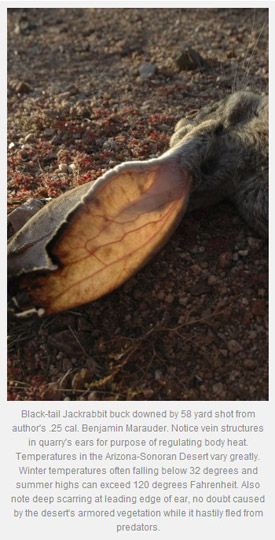 The resounding smack of the 31 grain Barracuda Pellet connecting with it’s intended target sounded like a rug beinghit with a golf club! The big jack piled up instantly on top of himself with only a few fleeting leg kicks from no longer having a functioning heart or lungs to provide oxygen. “Well that sounded solid. I heard that all the way over here!”, Scott said from about 50 yards away, his angle of approach leaving him making his way up out of the bottom of the 60 foot-deep arroyo still.
The resounding smack of the 31 grain Barracuda Pellet connecting with it’s intended target sounded like a rug beinghit with a golf club! The big jack piled up instantly on top of himself with only a few fleeting leg kicks from no longer having a functioning heart or lungs to provide oxygen. “Well that sounded solid. I heard that all the way over here!”, Scott said from about 50 yards away, his angle of approach leaving him making his way up out of the bottom of the 60 foot-deep arroyo still.
Black-tailed Jackrabbit (Lupus Californicus) facts:
-aren’t rabbits at all, but are hares.
-can run up to 45 mph in short bursts.
-rest and sleep in a “form”, a shallow depression scraped in the ground.
-young jackrabbits are called “leverets”.
-females reproduce up to 4 times in a year.
-re-ingest their dropping -they eat their food twice.
-leverets are born after a 41 to 48 day gestation period
-their meat contains little fat or protein, making them a poor food source.
-like deer, males are called “bucks”, just as females are referred to as “does”.
Scott and I both admired the jack’s beauty, especially it’s lush winter pelt and, both picking him up like two elderly ladies inspecting produce at the local grocery, guessed him to weigh somewhere around 9 lbs (I have recently purchased a digital fish scale that weighs to the nearest 1/10 ounce and due my scientifically curious nature am excited to put it into use in the field). We both noted the dense fur that lines between the pads of the hares feet, believed to allow it to travel the hot, sun-baked sandy washes they seem to prefer.
We spent the next two hours continuing on our hunt, jumping a handful of other jacks, none of which presented shots within range of an airgunner. In fact, after spending a few consecutive weekends hunting this area, we’ve concluded that the area’s popularity and subsequent heavy use during Arizona’s winter quail hunting months is the cause of the jacks fleeing at 130-150 yards instead of the 30-40 yards that seems to be more common of the species.
With any time in the desert airgun hunting the black-tailed jackrabbit, one quickly learns to view getting even just the opportunity to squeeze the trigger with one in your scope to be considered a successful day in the field. With this in mind, I was even more pleased to actually have had the good fortune of taking one.
Useful Information for Airgunners Interested in Hunting this Area:
 Topo map and GPS Coordinates of this location: USGS Map Name: Humboldt Mountain, AZ Map MRC: 33111H7
Topo map and GPS Coordinates of this location: USGS Map Name: Humboldt Mountain, AZ Map MRC: 33111H7
N33.89892° W111.75135° Datum: NAD27
Hunting licenses (non-resident and 3-day non-resident licenses must be applied for ) can be obtained by visiting the Arizona Game and Fish Department on the web here: http://www.azgfd.gov/eservices/licenses.shtml
This area is part of Arizona’s Tonto National Forest and a one day use pass must be purchased for each vehicle used per day. More information can be found here: www.fs.usda.gov
The Arizona desert in the winter can have vast temperature swings from early morning to mid-afternoon, airgunners are advised to dress in layers to aide in regulating body temperature to match the conditions of the day.
As always, carry more water than you feel you should require. A good rule of thumb is one litre (.26 gallons) of water per hour of time in the desert during the winter. Double this figure in warmer months.
Every plant in the desert is armored, wear appropriate clothing and footwear.
The airgunner that does his or her homework and is familiar with their setup’s trajectory at longer ranges will have greater success in this style of hunting. Chairgun Pro is an indispensable piece of freeware to aid the airgun hunter and is offered by Hawke Sport Optics. Chairgun Pro can be downloaded free of cost at the following link: http://www.chairgun.com/
About “azairgunner”
J.K. Chlarson is an architectural designer living in Scottsdale, Arizona with a love of all things air powered and accurate. You can find him in the foothills of the Arizona-Sonoran Desert with a .25 caliber PCP slung over his shoulder, a Nikon DSLR hanging from his neck and a smile on his face as he re-lives his boyhood wandering the Apache-Sitgreaves National Forest with a Crosman 760 wondering what adventure lied just over the next hill.
- Airgun Hunting Arizona’s Jackrabbit - November 17, 2012

